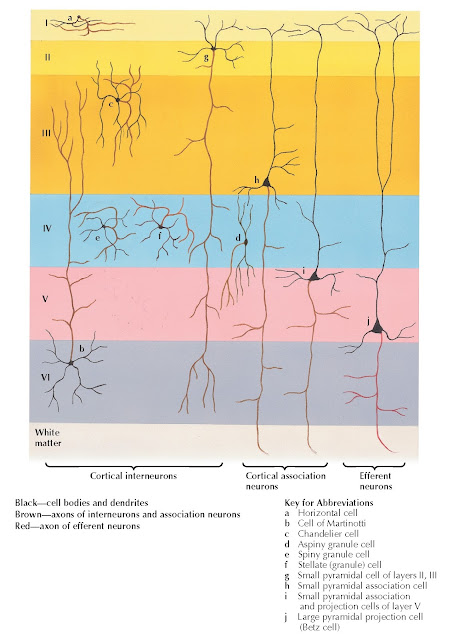TYPES OF NEURONS IN CEREBRAL CORTEX
The six layers of the cerebral cortex contain different types of neurons, which can be broadly classified as interneurons, association neurons, and efferent (projection) neurons.
Interneurons. Interneurons have axons that do not leave the cortex and may be of several kinds. The most common are stellate (star-shaped), or granule, cells, which have symmetrically branching dendritic trees and short axons that end upon nearby neurons. These cells are especially prevalent in layer IV, which is accordingly named the “granule cell layer.” Other interneurons are horizontal cells, which are found in layer I; Martinotti’s cells, which are located in deeper layers and send axons toward the cortical surface; and the small pyramidal cells of layers II and III, which send axons to deeper layers.
Association Neurons. Association neurons are small pyramidal cells found in the deep parts of layer III or in the superficial parts of layer V; they send axons through the white matter to other regions of the cortex.
Efferent Neurons. Efferent neurons
leave the cortex to innervate structures in the brainstem or spinal cord and
originate from the giant pyramidal (Betz) cells in layer V or from
spindle-shaped cells in layer VI. In addition to their main axons, which leave
the cortex, efferent neurons may also have collateral axons, which project to nearby cortical neurons for
association.
 |
| Plate 2-17 |
Afferent Fibers. Two major classes of nerve fibers bring
information to the cortex. Specific cortical afferent fibers, which
originate in corresponding thalamic relay nuclei, project to layer IV to end in
a highly branched terminal arborization. Nonspecific cortical afferent
fibers, which originate in the thalamus or in other areas of the cortex and
ascend through the entire depth of the cortical gray matter, giving off
terminal branches in all layers. Specific afferent fibers may thus activate
granule cells and efferent neurons of layers III, V, and VI (via their
dendrites in layer IV), whereas nonspecific afferents may influence all classes
of cortical neurons. Neurons activated by incoming fibers relay information to other cortical neurons via intrinsic
connections within the cortex.
Cortical Organization. An important aspect of the flow of information
mediated by cortical neurons is that it occurs predominantly in a vertical
direction across the six cortical layers. With the exception of the
horizontal cells of layer I, there are very few cortical neurons that relay
activity laterally over any significant distance. The vertical cell axons and
dendrites are arranged within the cortex in columns of neurons that have
similar properties. These columns are approximately 0.5
to 1.0 mm wide and extend across all six cortical
layers. In the sensory cortex, neurons within an individual column all respond
to the same stimulus; within the motor cortex, the activity of all neurons in
one column is related to the activity of a single muscle or muscle group. These
columns, as well as the underlying vertical neural organization, appear to
represent one of the central features of information processing by the cerebral
cortex.




